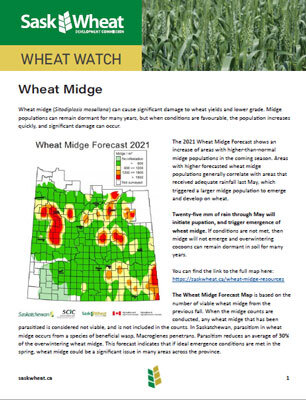Agronomic Resources | Wheat Profit Podcast | Fusarium Resources | Wheat Midge Resources | Harvest Resources | Durum Production Manual
Wheat Midge Resources
Wheat Watch
This issue of Wheat Watch explains the potential threat of wheat midge in 2021 and includes scouting and control tips for managing the pest.
CLICK HERE or the image to the left to open the edition of Wheat Watch
Wheat Midge Forecast Map
The Saskatchewan Wheat Midge Forecast Map for 2023 (2022 data) shows increased numbers of wheat midge compared to the relatively low counts for the 2022 forecast (2021 data). Several regions in north-central and central regions experienced increased wheat midge sample numbers. These apparently coincided with timely spring rainfall.
At least 25 mm of precipitation prior to the end of May is required for proper development; lower levels reduce emergence of adults. Many regions saw inadequate rainfall for development. Emergence can be delayed, extended or erratic and may not coincide with the susceptible stage of the wheat crop.
Importantly, counts greater than 600 wheat midge per square metre (yellow and orange) on the wheat midge map may still result in significant damage and yield loss, especially if springtime environmental conditions are favourable. In 2022, 345 samples were collected to produce the 2023 forecast map. Not all fields are sampled. The intention of the forecast is to provide a regional representation of wheat midge populations present in the fall of 2022.
To determine midge populations and, if necessary, timing of an insecticide application, growers are urged to monitor conventional wheat fields during the susceptible period – when the wheat head becomes visible as the boot splits until mid-flowering (anthesis). Regular field scouting on successive nights is important to understand wheat midge population changes in a particular field. Temperature and wind conditions significantly influence egg-laying by the adult female midge. High temperatures and high winds tend to reduce activity of egg-laying female midge.
There are options for managing wheat midge. If spring wheat is planned as part of a rotation, there are midge-tolerant wheat varieties available as varietal blends (VB). For 2023, VBs are available in CWRS, CPSR, CWSP, CWSWS, CWHWS, CNHR, CWES, and Durum wheat classes. Visit the Midge Tolerant Wheat Stewardship Team website for information on midge-tolerant wheat and VBs. Also, refer to the 2023 Saskatchewan Seed Guide for information.
You can also consider crop rotation to a non-host crop. Since spring wheat is the primary host for wheat midge, planting a non-susceptible cereal crop (e.g. oats, barley) or a broadleaf crop (e.g. canola, pulse) is a good option.
Cost-Benefit Analysis of Midge Tolerant Wheat
Midge Tolerant Wheat
The Midge Tolerant Wheat Stewardship Team is a broad industry coalition representing plant breeders, government, seed growers, seed distributors and producer groups. The team is committed to maintaining the viability of Midge Tolerant Wheat by educating Canadian wheat producers on the importance of proper stewardship of the technology.





